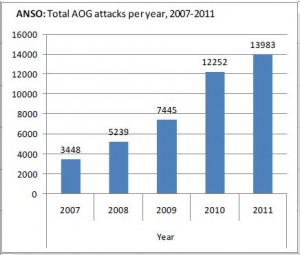McCain, Lieberman and Graham Attempt to Revive Mass Delusion on Afghan “Success”
In yesterday’s post, I pointed out the craven political decision to delay a strategic reassessment of the war strategy in Afghanistan until after the election in November. Just in case that was not enough stupidity already emanating out of Washington regarding Afghanistan, today we have the collected wisdom of John McCain, Joe Lieberman and Lindsey Graham informing us that not only is there success in the war effort in Afghanistan, but the US must listen closely to them in order to sustain that success. In preparation for reading the recommendations from our trio of uninvited experts, it is useful to look once again at the accompanying chart, where we see the steady increase in violent events in Afghanistan. The surge of troops in early 2010 did not reverse the trend of increasing violence. In fact, violence jumped by an even larger amount in the first year of the surge than in previous years. No benefit of the surge accrued in 2011, either, as the number of violent events continued to increase.
But McCain, Lieberman and Graham would have us believe that there is “success”:
Significant military progress has been made in Afghanistan — progress that we have personally witnessed over repeated visits. Four years ago, southern Afghanistan was overrun by the Taliban, and our coalition lacked the resources and the strategy necessary to break their momentum. Today, that situation has been reversed, thanks to the president’s surge of forces, the leadership of talented military commanders, and the courage and perseverance of our troops.
Similarly, our effort to build the Afghan National Security Forces — which was under-resourced and disorganized four years ago — has been overhauled. Growing numbers of Afghan units are increasingly capable of leading the fight.
Of course, given the current clusterfuck that is reality in Afghanistan, our mentors of mendacity were forced to open their piece with a nod to the growing desire by most Americans to get out sooner rather than later:
A series of tragic events in Afghanistan has increased the desire of a war-weary public to end our mission there. As heart-wrenching as these events have been, they do not change the vital U.S. national security interests at stake in Afghanistan, nor do they mean that the war is lost. It is not. There is still a realistic path to success if the right decisions are made in the coming months.
And just what is the “realistic path to success” that is being offered for our consideration? Read more →

